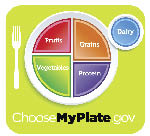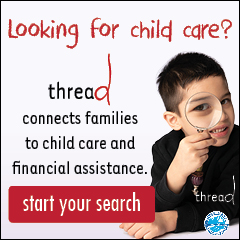
Childhood obesity:
Beyond baby fat
What you can do now to prevent
weight problems later
Story by Sarah Gonzales
There’s nothing cuter than a chubby baby, right? But contrary to the notion that a chubby baby is a healthy baby and that baby fat will disappear, recent studies show that overweight infants and toddlers are at a higher risk for obesity later on.
“(It’s) a myth that children outgrow their overweight,” says Bret Luick, PhD, nutrition specialist at the University of Alaska Fairbanks Cooperative Extension. “In fact, they carry it forward.”
The statistics are startling: Childhood obesity has tripled in the last 30 years, and it is showing up earlier in life than ever before. About 10 percent of children from infancy to age 2, and more than 20 percent of children ages 2 to 5, are overweight or obese, according to a recent Institute of Medicine repo
rt. In Alaska, 40 percent of 3 year olds are overweight. The state’s Department of Health and Social Services (DHSS) estimates that 1 in 3 children entering kindergarten or first grade are overweight or obese.
As in adults, excess weight in kids increases their risk for a multitude of serious health problems. Diabetes, heart disease and some cancers are almost entirely directly related to obesity. Type 2 diabetes – formerly known as adult-onset diabetes – is now rising at an alarming rate among children and teens, according to the Centers for Disease Control.
To give children their best shot at a healthy future, health experts agree that we need to start early in the battle against obesity. Here are some key strategies for keeping our babies, toddlers and preschoolers from becoming overweight.
A healthy start
Infants who are breastfed exclusively for at least six months from birth have lower rates of obesity later in life. “It has a strong protective effect,” explains Diane Peck, community and evaluation specialist with the Obesity Prevention and Control Program at the DHSS. She says that while the American Academy of Pediatrics (AAP) makes this recommendation, the exact science behind why it helps to prevent obesity is still being researched. But, experts suspect that breastfed infants might be better able to control the amount of the milk they consume. “Their intake may be better than bottle-fed babies and often bottle-fed babies are encouraged to finish the bottle,” Peck says, explaining one hypothesis. Plus, there is leptin in breastmilk, a hormone that helps to regulate how energy stores, like body fat, are burned.
However, while 75 percent of mothers start out breastfeeding, only 13 percent of babies are exclusively breastfed at the end of six months, says the CDC. The success rate among mothers who want to breastfeed can be improved through active support. (Read more in our breastfeeding article.)
While baby fat may prove to be a predictor of being overweight in childhood, no one is suggesting putting babies on diets. Babies who are exclusively breastfed or bottle-fed should never be denied the breast or bottle. Once solid foods are introduced, however, parents can and should make healthy choices for their children.
On to solid foods
By the time a child has reached the age of 1, he should be introduced to a variety of healthy, solid foods. At this age, says Peck, who is also a registered dietician, the ideal diet would have “a variety of fruits, vegetables, whole grains, lean meats and milk – really the same healthy diet for a 1 year old is going to be the same for a 3 year old, or for an adult!”
So, where does a caregiver find out how much a 1 year old, a 3 year old or a 5 year old is supposed to eat of these healthy foods? Well, start by saying goodbye to that baffling pyramid because keeping track of a nutritious diet just got much easier.

The US Department of Agriculture’s guidelines have been simplified with the introduction of the “Choose My Plate” initiative – and it applies to both adults and children.
“The pyramid was very difficult for people to grasp the concept of what you were supposed to be eating,” says Peck. “Choose My Plate is much simpler: Half of the plate is vegetables and fruits, then a small portion of whole grains and small portion of lean protein.” Add a glass of low-fat or nonfat milk and it’s a complete meal that satisfies all the food groups.
While dietary recommendations are much the same for children ages 2 and up as they are for adults, a child-sized portion will be much less than an adult-sized portion. The AAP’s HealthyChildren.org website contains nutritional guides by developmental stage, and offers simple rules of thumb for judging portions such as measuring one tablespoon of each food for every year of a child’s age.
While today’s guidelines are more about portion control than counting calories, says Peck, caregivers can still learn what the recommended daily intake of calories should be by visiting ChooseMyPlate.gov.
The juice on beverages
Excess juice can be a subtle cause of infant obesity, according to the AAP. “A lot of parents think that 100-percent fruit juice is healthy, and while it does have vitamins in it, there are a lot of calories in juice,” explains Peck. “The AAP recommends two to four ounces per day of 100-percent fruit juice for kids who are 1 to 2 years of age, and four to six ounces for kids who are 2 to 6 years old.” Considering that most juice boxes come standard in either 4.23 or 6.75 ounce sizes, it’s understandable that it can be easy for kids to drink too much of the stuff.
Watering down juice is a simple solution, or drinking water or milk. The AAP recommends that children 1 to 2 drink whole milk, while children 2 and up drink low-fat milk, says Peck.
Get moving!
Studies suggest that inactive children are that way from infancy. The less active the child is, the more chubby he becomes, which leads the child to become less interested in physical activity. Unfortunately, with time, a vicious cycle of inactivity and fatness results. That’s why it’s important to get moving sooner than later.
The Let’s Move! initiative, launched by the First Lady, is focusing on the nation’s youngest residents – infants, toddlers and preschoolers – to solve the epidemic of childhood obesity within a generation. The program recommends that preschool children be offered at least 120 minutes of active time each day. Infants and toddlers should be getting at least 60 minutes of active time each day. Peck adds that preschoolers should not be sitting for more than 60 minutes at a time (exclusive of naps).
Make physical play part of your family’s daily routine by taking family walks or playing active games together. Encourage your kids to move regularly – whether that’s crawling on the floor or running through the park. Activities like soccer, swimming, gymnastics and dance programs are exciting and challenging enough to keep them engaged. Babies might not be able to run and play like the “big kids” just yet, but there’s lots they can do to keep their little arms and legs moving throughout the day. Get down on the floor and play with your baby. Give them “tummy time” – spending time on their stomachs helps them see, touch and feel what’s around them, as well as strengthen muscles and reach movement milestones.
Also, make a commitment to get healthier yourself. Children of overweight parents are far more likely to be overweight themselves. Some of it is genetic, but a lot of it is related to the eating and exercise habits of the family. Set a good example for your children (and feel better as you do!).
It takes a village
While many measures for preventing obesity can start at home, it’s really a cultural attitude shift that will see the most results, says Peck, with people working together to answer the question: “How can we help to make the environment a place where healthy choices can be made?”
One researcher at the University of Alaska Fairbanks is looking into exactly that. Dr. Bret Luick heads a new sub-project that will study childhood obesity in kids ages 2-8 in Alaska as part of a larger project that includes all of the Pacific Rim. His project will research how active children are throughout the day, as well as studying what they eat. They hope to work with childcare centers and with communities to learn how good habits can be established early in a child’s life.
“It’s not any single point problem with any one child or one family, ” Dr. Luick says, convinced that preventing childhood obesity must be a community- or larger-based effort. “It’s our food system, it’s how we structure time at school, it’s how we spend our lives, it’s active lifestyles, eating nutritious food, avoiding foods that are energy dense. This is the way to go. It’s not one thing; it’s a community-level process.”
Together, our involvement is key to ensuring a healthy future for our children.










